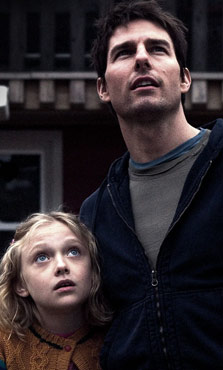 Any adaptation of H. G. Wells’ “War of The Worlds” is likely to suffer from a schizophrenic personality. One half of the bipolar dynamic is a big, exciting, cosmic adventure full of action and aliens. The sheer scale of the story is perfect for a summer popcorn movie. But the other half is insular, character-driven, and passive. It relies on psychological suspense rather than explosive set-pieces. Each of these is part of Wells’ book, and each demands a corresponding kind of directorial talent to pull off. Any adaptation of H. G. Wells’ “War of The Worlds” is likely to suffer from a schizophrenic personality. One half of the bipolar dynamic is a big, exciting, cosmic adventure full of action and aliens. The sheer scale of the story is perfect for a summer popcorn movie. But the other half is insular, character-driven, and passive. It relies on psychological suspense rather than explosive set-pieces. Each of these is part of Wells’ book, and each demands a corresponding kind of directorial talent to pull off.
Steven Spielberg is probably one of the few directors in Hollywood capable of pulling off the twin feats of a lavish, big-budget sci-fi film co-existing alongside a smaller, white-knuckle point of view thriller told from a single man’s perspective. For long stretches of “War Of The Worlds” he succeeds in doing just that. The opening sequence, in which the Martians land on Earth, flying down lightning slides into their waiting war machines, not only impresses with its visual flair but builds, step by step, from an eerie series of suggestive moments—the wind, the silence (but for a barking dog), the lump-in-the-throat walk to the site of the lightning strike, the gradual crumbling of the pavement—to the sudden eruption of terror and widespread destruction as the Martians emerge (buildings collapse, people are vaporized, exquisitely torturous fear becomes jitterbug panic). Spielberg expertly follows his hero (Tom Cruise) throughout this sequence, oscillating expertly between the perspective of one man and many.
“War Of The Worlds” is spotty the rest of the way. There are scenes of unforgettable horror, mostly oblique, sometimes poetic. An Armageddon-style clash with the Martians is indicated by sound and flashes of light over a hilltop, as Cruise argues desperately with his son not to join with the military forces which will soon meet a grisly fate. Little of the “battle” is shown. Spielberg sticks with Cruise. We only get shots of flaming tanks come flying backward in retreat to indicate the immensity and totality of the Martian victory. Other scenes are quick-hitters, like a train that rushes by, gutted by flames that send an ominously beautiful shower of sparks over the stunned crowd at the rail crossing. The movie’s most chilling moment comes when Dakota Fanning goes to the river for a bathroom break and sees first one, then an entire crowd of corpses floating down the serene river like so many leaves carried along the glassy surface. After “Schindler’s List” and “Saving Private Ryan”, Spielberg knows how to leave his audiences dumbstruck with carnage.
As somber as those scenes are, Spielberg shows off another, more impish streak that has been sorely lacking in his recent films. Here and there, “War of The Worlds” actually sneaks in some amusing, comic book style moments that give away the film’s debt to its pulpy predecessors. The Martian ray-beams that disintegrate fleeing humans becomes almost comic in its 1950s sci-fi cheesiness. The effects are cutting edge, but at heart the Martian’s preferred method of killing is still the same death-ray that Tim Burton used to hilarious effect in “Mars Attacks!” The Martians also “harvest” the humans, a tactic not used by the invaders in Wells’ novel. Hiding in a basement, Cruise watches as one unfortunate man is slammed to the ground and milked, still twitching, for his blood, which shoots back into the Martian tripod. From there, it’s sprayed out to create the creepy red weed that chokes off the landscape. The variation on the wood-chipper scene in “Fargo” is so over the top it’s comic.
Another sly touch is the incompetence and facelessness of the military men, however, which are every bit the anonymous green-clad victims they were in the golden age of B-movie sci-fi shockers. It’s nice to see Spielberg shed the annoying piety toward the military that has developed so strongly in his work.
Family values, alas, are omnipresent. Because Dakota Fanning can act, and Tom Cruise is allowed a slightly edgier role as an irresponsible father, none of the human interest subplot ever turns rancid, exactly. Besides, thrillers need rest-stops, and drippy detours into feel-good nuclear family blather are as routine in Spielberg films as John Williams’ music. The movie’s last scene, in which order is restored—that is, Daddy is once again King and Ruler—is so perfunctory, so expected, that it may as well be the studio logo at the end of the credit crawl. Apparently Spielberg felt he needed the human interest of a dysfunctional family, his fear being that the gory and immediate extinction of the human race wouldn’t be quite enough to sustain an audience’s interest. This added nonsense was the worst violence done to Wells’ novel, but the bleakness of Spielberg’s apocalyptic undertones makes up for the treacle on the surface. |